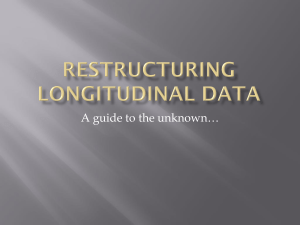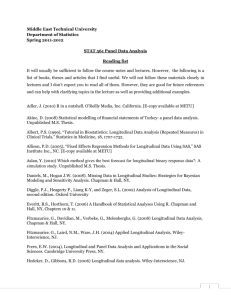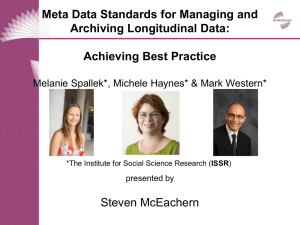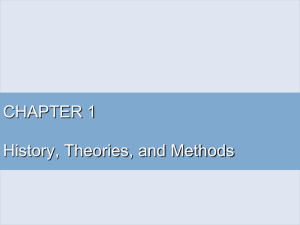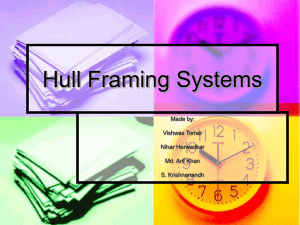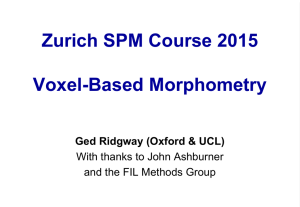MS PowerPoint (PPTX format)
advertisement
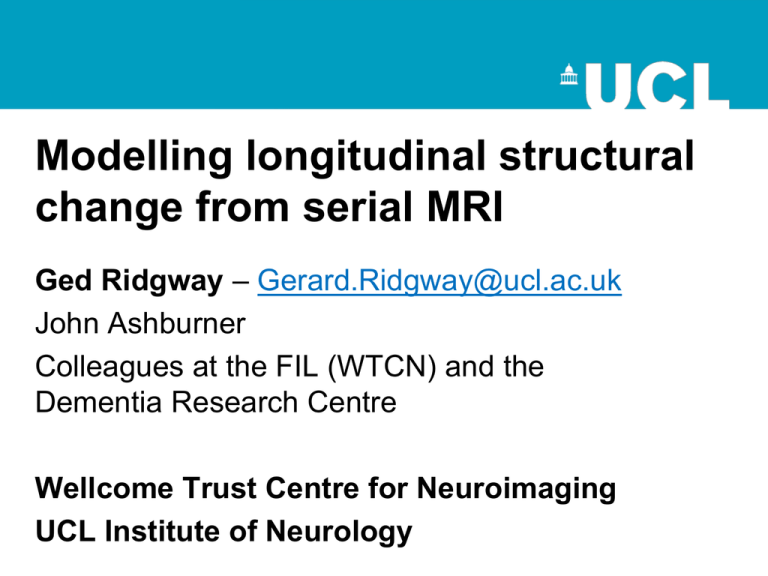
Modelling longitudinal structural change from serial MRI Ged Ridgway – Gerard.Ridgway@ucl.ac.uk John Ashburner Colleagues at the FIL (WTCN) and the Dementia Research Centre Wellcome Trust Centre for Neuroimaging UCL Institute of Neurology Overview • • • • • • Motivation for longitudinal data Need for appropriate statistical analysis Benefits of longitudinal image processing Risk of bias from asymmetric processing Longitudinal imaging in SPM12 Unbalanced data and further extensions Motivation for longitudinal data • Development, growth, plasticity, aging, degeneration, and treatment-response are inherently longitudinal • Serial data have major advantages over multiple cross-sectional samples at different stages • Increasing power – Subtlety of change over time vs. inter-individual variation • Reducing confounds – Demonstrating causality with interventions – Separating within-subject changes from cohort effects Example: Training & structural plasticity • Intervention (training) + longitudinal data allows causal interpretation of change, cf. just difference • Draganski et al. (2004) Neuroplasticity: Changes in grey matter induced by training – “volunteers who learned to juggle … transient and selective structural change in brain areas associated with processing and storage of complex visual motion” • Draganski et al. (2006) Temporal and spatial dynamics of brain structure changes during extensive learning Example: Training & structural plasticity • Scholz et al. (2009) Training induces changes in white matter architecture Example: Training & structural plasticity • Comments & Controversies, NeuroImage, 2013, 73:225–267 • Thomas & Baker: Teaching an adult brain new tricks: A critical review of evidence for training-dependent structural plasticity in humans • Erickson: Evidence for structural plasticity in humans: Comment on Thomas and Baker (2012) • [ Jones et al: White matter integrity, fiber count, and other fallacies: The do's and don'ts of diffusion MRI ] • Draganski & Kherif: In vivo assessment of use-dependent brain plasticity—Beyond the “one trick pony” imaging strategy • Fields: Changes in brain structure during learning: Fact or artifact? Reply to Thomas and Baker Thomas & Baker: On evidence, biases and confounding factors: Response to commentaries Example: Alzheimer’s disease evolution • Multiple sources of cohort effects – Birth-year (nutrition, etc.) – Disease onset-time cohorts – “Healthy survivor effect” • Timescales too long for pure longitudinal studies – “Unstructured multicohort longitudinal designs” • See Thompson et al. (2011) – [source of figure on next slide…] Example: Alzheimer’s disease evolution Further statistical issues • Even simple designed experiments have pitfalls • Usually seek group-by-time interaction – Not significant change in one group but not another – Not group difference at one time-point but not another • Can’t ignore dependence within-subject over time • In an ANOVA with group and time factors: – Time effects can relate to (smaller) within-subject var. – Group differences must relate to between-subject var. – Group-by-time interaction … Benefits of longitudinal image processing • Smaller within-subject variation motivates longitudinally-tailored image processing methods • Boundary shift integral (BSI) – Intensity difference after rigid registration over region from brain masks more precise than mask volume diff. • Non-rigid registration “Jacobian-integration” – JI over segmented region more precise than multiple independent segmentations (example following…) • Temporally-constrained/regularised “4D” methods – E.g. Xue’s CLASSIC, Wolz’s 4D graph-cut Longitudinal imaging animations Interpolating rigidly aligned images Warping average by interpolated transform Interpolating volume change (divergence) relative to the average Benefits of longitudinal image processing • Anderson et al. (2012) Gray matter atrophy rate as a marker of disease progression in AD Risk of bias from asymmetric processing • Within-subject image processing often treats one time-point differently from the others – Later scans registered (rigidly or non-rigidly) to baseline – Baseline scan segmented (manually or automatically) • Asymmetry can introduce methodological biases – E.g. only baseline has no registration interpolation error – Baseline seg. more accurate than propagated segs. – Change in later intervals more regularised/constrained Risk of bias from asymmetric processing • Theory known for a long time (but often ignored) – Ashburner et al. 1999; Christensen, 1999; Cachier & Rey, 2000; Smith et al. 2001 • Demonstrated in practice recently as a serious issue – Thomas et al. 2009; Yushkevich et al. 2010; Thompson & Holland 2011 Risk of bias from asymmetric processing • Comments & Controversies, NeuroImage, 2011, 57:1-21 • Thompson & Holland: Bias in tensor based morphometry Stat-ROI measures may result in unrealistic power estimates • Hua et al: Accurate measurement of brain changes in longitudinal MRI scans using tensor-based morphometry • Fox et al: Algorithms, atrophy and Alzheimer's disease: Cautionary tales for clinical trials • Reuter & Fischl: Avoiding asymmetry-induced bias in longitudinal image processing Longitudinal image processing in SPM12 • Ashburner & Ridgway (2013) • “Unified” rigid and non-rigid registration with model of differential intensity inhomogeneity (bias) • “Generative” – each time-point is a reoriented, spatially warped, intensity biased version of avg. • “Symmetric” with respect to permutation of images • “Consistent” with direct registration between pair • “Diffeomorphic” – complex warping without folding Generative model Average image Inhomogeneity regularization Timepoint Inhomog. correction field Registr. (velocity) regularization Velocity Non-rigid Transform Rigid parameters Rigid Transform Noise-level N Example result – Alzheimer’s disease subject • Above: Images aligned only rigidly (OASIS data) • Below: Non-rigid volume change (divergence) Example result – Group averages • • • • 82 subjects from OASIS longitudinal data (part 1) DARTEL for between-subject spatial normalisation Divergences transformed without modulation Next step could be SPM statistical analysis… Terminology: TBM, DBM & (longitudinal) VBM • (Deformation) Tensor-based morphometry (TBM) – Davatzikos et al. (1996); Chung et al. (2001) – SPM-like (mass-univariate) analysis of Jacobian or div • See also mass-multivar. “generalized” TBM (Lepore et al. 2008) • Deformation-based morphometry (DBM) – Ashburner et al. (1998) – Multivariate analysis of displacement vector patterns • Longitudinal VBM (Kipps et al. 2005) – Tissue-specific volume-change (using segmentation) Longitudinal statistical modelling in SPM • “Balanced” data (e.g. designed experiment) – Same number (and timing) of time-points over subjects – Repeated-measures / within-subject ANOVA – Dependence within specified factor(s) • “Unbalanced” data (e.g. observational study) – E.g. more frequent observation closer to onset (DIAN) – Two-stage (fMRI-like) analysis of summary statistics – E.g. straight line or polynomial regression coefficients • Sub-optimal if times vary dramatically (singletons dropped) Other statistical modelling approaches • Bernal-Rusiel et al. (2012) Statistical analysis of longitudinal neuroimage data with Linear Mixed Effects models. [FreeSurfer] • Chen et al. (2013) Linear mixed-effects modeling approach to FMRI group analysis. [AFNI] • Li et al. (2013) Multiscale adaptive generalized estimating equations for longitudinal neuroimaging data. [unbalanced … twin and familial studies] • Bayesian spatio-temporal modelling in SPM… Demo of longitudinal imaging in SPM12 • Beta version released in December 2012 (phew!) – http://www.fil.ion.ucl.ac.uk/spm/software/spm12/ – Frequent updates until final release • Record (and ideally report) the SPM12 revision number (r5360) – Longitudinal registration relatively stable • No longitudinal examples in SPM manual yet – Possibly after SPM course in May… – Support on SPM list, or email me (don’t email John!) • http://www.fil.ion.ucl.ac.uk/spm/support/ No Longitudinal button, but found in Batch menu, like Dartel, etc. Choice of paired or general serial. No difference in model, but easier specification and results for pairs. Specify Time 1 scans for all subjects, then all Time 2 scans (in same order!) Vector (list) of time intervals (yr) Default values can be left; NaN to automatically estimate (Rician) noise levels One module per subject (scripting required if many subjects!) Select all scans for this subject Vector (list) of times relative to arbitrary datum (e.g. baseline=0) Jacobian output useful to quantify interpretable ROI volumes (in litres) • Output/results – Average image – Jacobians or divergences – Deformations • Next steps – Segment avg – Run Dartel/Shoot – Warp e.g. dv to standard space – SPM stats on dv (TBM) – Or combine with seg of avg (VBM) Modelling longitudinal structural change from serial MRI Ged Ridgway – Gerard.Ridgway@ucl.ac.uk This work was supported by the Medical Research Council [grant number MR/J014257/1] The Wellcome Trust Centre for Neuroimaging is supported by core funding from the Wellcome Trust [091593/Z/10/Z]
